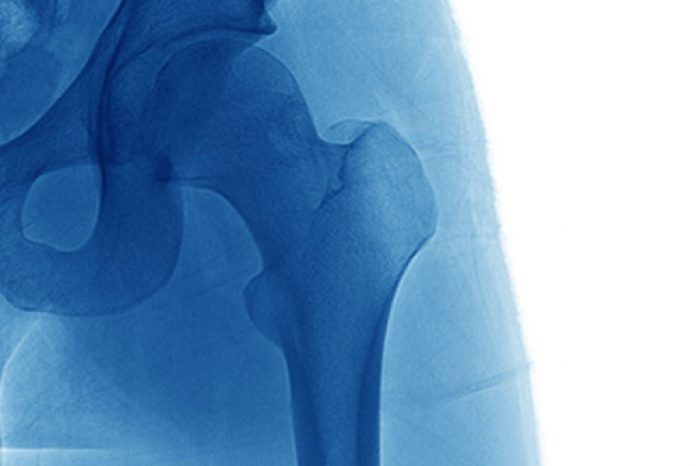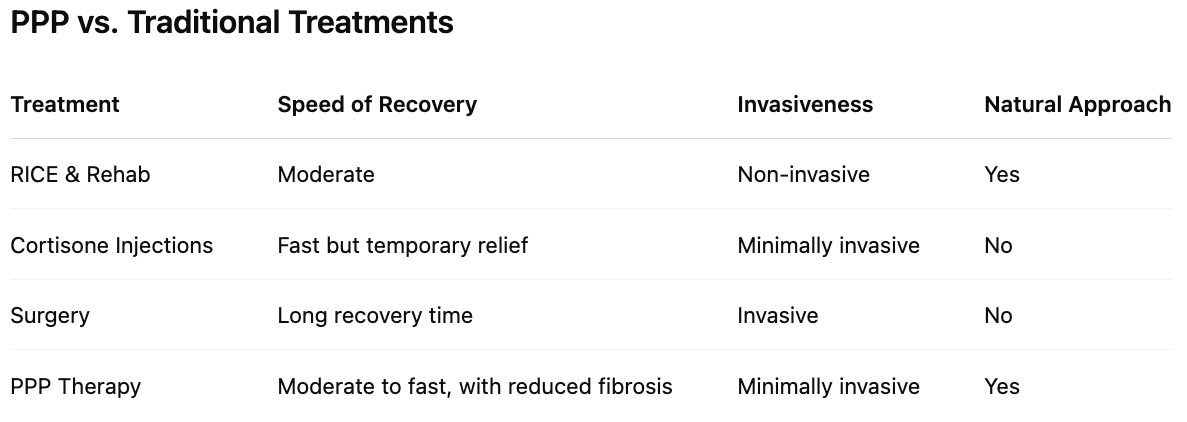
Muscle injuries are among the most frequently encountered problems in athletes and active individuals. While the risk varies by sport, these injuries account for roughly 29% of all sports-related injuries, with particularly high rates observed in baseball and track and field events [Camp et al, 2018; Brubaker & James, 1974; Ahmad et al, 2013].
Conventional treatments like rest, ice, compression, and elevation (RICE), along with physical therapy, can support recovery—but the healing process is often slow. Even more concerning, re-injury rates exceed 30%, frequently delaying an athlete’s return to full participation [Orchard et al, 2005].
Healing from muscle damage is a complex physiological process, and newer regenerative therapies have gained attention for their potential to enhance recovery. Among them, Platelet-Rich Plasma (PRP) has shown promise in treating various musculoskeletal disorders such as knee osteoarthritis, tennis elbow, rotator cuff injuries, and gluteal tendinopathy [Filardo et al, 2021; Ben-Nafa et al, 2018; Hamid et al, 2021; Fitzpatrick et al, 2019; Fitzpatrick et al, 2018].
However, the role of PRP in treating acute muscle injuries is still debated. While some clinical and cellular studies suggest it may help, others—including randomized controlled trials—have found limited or no benefit in this context [Hamilton et al, 2015; Martinez-Zapata et al, 2016; Reurink et al, 2014; Miroshnychenko et al, 2017].
Emerging evidence has built the case for utilizing platelet-poor plasma (PPP)—the fraction of plasma left after most platelets are removed—as a potentially more suitable alternative for muscle repair for muscle injury [Miroshnychenko et al, 2017; Kasitinon et al, 2021; Kruse et al, 2025]. In this post, we’ll explore how PPP works, why it's so promising for muscle injuries, and what the research says about its effectiveness.
PRP, or Platelet-Rich Plasma, is a concentrated solution of platelets derived from your own blood. Platelets are known for their role in clotting, but they also carry growth factors and cytokines that help regenerate tissue and promote healing.
Blood is drawn from the patient.
It’s spun in a centrifuge, separating the components.
The platelet-rich portion is extracted and injected into the injury site with ultrasound guidance.
While Platelet-Rich Plasma (PRP) has gotten most of the spotlight in regenerative medicine, Platelet-Poor Plasma (PPP) is quietly emerging as a promising alternative—especially when it comes to treating muscle injuries.
PPP is the portion of your blood plasma that remains after most of the platelets have been removed during the centrifugation process. In contrast to PRP, which is packed with growth factors and platelets, PPP contains:
While that might sound like a disadvantage, PPP's lower concentration of bioactive compounds can actually be beneficial in specific cases—particularly when managing acute muscle injuries, where too much inflammation or fibrosis (scar tissue) could hinder proper healing.
Muscle injuries, including strains, tears, and contusions, often heal slowly due to limited blood supply in the affected tissues. PPP helps overcome this by:
Delivering growth factors directly to the injury
Stimulating tissue regeneration
Reducing inflammation
Accelerating collagen production
Recent studies show PPP can significantly improve healing time and muscle strength post-injury.
Kasitinon et al. (2021)
One of the first documented cases using PPP for the treatment of muscle injuries described a Division I college football kicker who sustained a grade II quadriceps strain, confirmed by MRI. After receiving a single PPP injection, the athlete showed significant improvement. Within four weeks, he was pain-free and symptom-free, and a follow-up MRI showed clear signs of healing [Kasitinon et al, 2021].
Kruse et al. (2025)
In what is currently the largest known study comparing PPP and PRP for acute muscle injuries, researchers analyzed a retrospective cohort of 100 athletes with thigh muscle strains. Athletes treated with PPP had an average recovery time of just over 28 days, returning to full activity faster than those who received PRP. Additionally, the PPP group reported less pain after the procedure and a shorter duration of discomfort, suggesting improved tolerability and potentially quicker rehabilitation outcomes [Kruse et al, 2025].

Current research on PRP suggests it may not fully achieve the goal of effectively promoting functional muscle regeneration. However, a growing—though still limited—collection of laboratory and clinical studies is beginning to highlight platelet-poor plasma (PPP) as a promising alternative. Evidence indicates that PPP may play a more effective role in guiding muscle stem cells to form contractile muscle tissue, potentially leading to quicker and more sustained healing following muscle injuries.
Ahmad CS, Redler LH, CiccottiMG, et al. Evaluation and management of hamstring injuries. Am. J. Sports Med. 2013; 41:2933–47.
Ben-NafaW,Munro W. The effect of corticosteroid versus platelet-rich plasma injection therapies for the management of lateral epicondylitis: a systematic review. SICOT J. 2018; 4:11.
Brubaker CE, James SL. Injuries to runners. J. Sports Med. 1974; 2:189–98.
Camp CL, Dines JS, Van Der List JP, et al. Summative report on time out of play for major and minor league baseball: an analysis of 49,955 injuries from 2011 through 2016. Am. J. SportsMed. 2018; 46:1727–32.
Filardo G, Previtali D, Napoli F, et al. PRP Injections for the treatment of knee osteoarthritis: a meta-analysis of randomized controlled trials. Cartilage. 2021; 13(1_suppl):364S–75S.
Fitzpatrick J, Bulsara MK, O’Donnell J, ZhengMH. Leucocyte-rich platelet-rich plasma treatment of gluteus medius and minimus tendinopathy: a double-blind randomized controlled trial with 2-year follow-up. Am. J. Sports Med. 2019; 47:1130–7.
Fitzpatrick J, Bulsara MK, O’Donnell J, et al. The effectiveness of platelet-rich plasma injections in gluteal tendinopathy: a randomized, double-blind controlled trial comparing a single platelet-rich plasma injection with a single corticosteroid injection. Am. J. Sports Med. 2018; 46:933–9.
Hamid MSA, Sazlina SG. Platelet-rich plasma for rotator cuff tendinopathy: a systematic review and meta-analysis. PLoS One. 2021; 16:e0251111.
Hamilton B, Tol JL, Almusa E, et al. Platelet-rich plasma does not enhance return to play in hamstring injuries: a randomised controlled trial. Br. J. SportsMed. 2015; 49:943–50.
Kasitinon D, Dragoo JL,Hwang CE. Use of platelet-poor plasma in acute quadriceps muscle strain in a division I football placekicker: a case report. Curr. Sports Med. Rep. 2021; 20:572–4.
Kruse RC, Eisenmann J, Glass NA, Petrachaianan K, Wilz L. Platelet-Poor Versus Platelet-Rich Plasma for the Treatment of Acute Thigh Muscle Injuries. Am J Phys Med Rehabil. 2025 Mar 1;104(3):250-256.
Martinez-Zapata MJ, Orozco L, Balius R, et al. Efficacy of autologous plateletrichplasma for the treatment of muscle rupture with haematoma: a multicentre, randomised, double-blind, placebo-controlled clinical trial. Blood Transfus. 2016; 14:245–54.
Miroshnychenko O, Chang W-T, Dragoo JL. The use of platelet-rich and platelet-poor plasma to enhance differentiation of skeletal myoblasts: implications for the use of autologous blood products for muscle regeneration. Am. J. Sports Med. 2017; 45:945–53.
Orchard J, Best TM, Verrall GM. Return to play following muscle strains. Clin. J. Sport Med. 2005; 15:436–41.
Reurink G, Goudswaard GJ,MoenMH, et al. Platelet-rich plasma injections in acute muscle injury. N. Engl. J. Med. 2014; 370:2546–7.
Adductor longus selective tenotomy is a modern surgical treatment for chronic groin pain that offers faster recovery and better outcomes than traditional full release surgery. The adductor longus, an inner thigh
Read MoreDiscover how ultrasound helps diagnose plantar fat pad atrophy, a leading cause of ball-of-foot pain. Learn about symptoms, thickness cutoffs, and why early detection matters for relief.
Read More